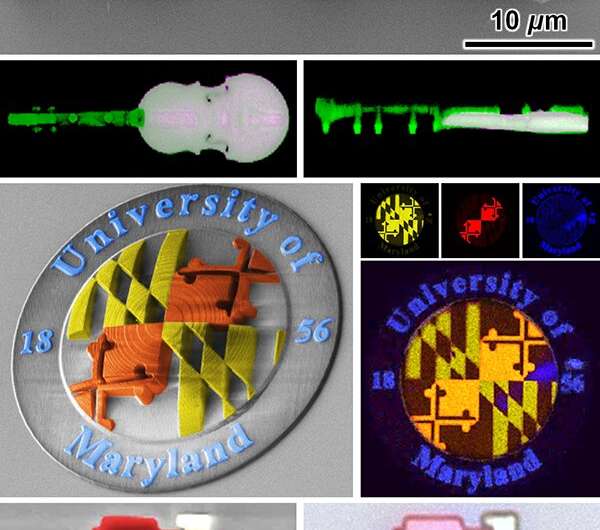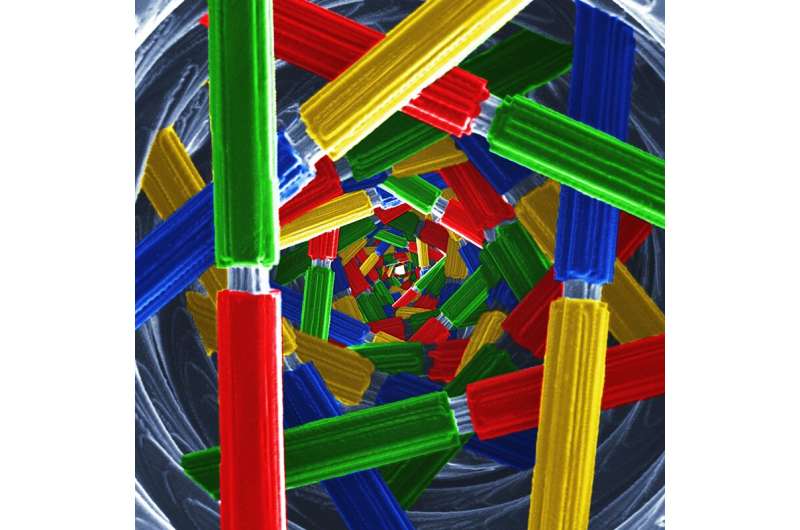New multi-material 3-D nanoprinting strategy could revolutionize optics, photonics and biomedicine

Engineers at the University of Maryland (UMD) have created a new multi-material 3-D nanoprinting technique that was featured on the inside front cover of the July 21 issue of Lab on a Chip.
The team's new technique—capable of printing tiny multi-material structures a fraction of the size of a human hair—offers researchers a faster, cheaper, and more accurate means to 3-D print these highly complex structures because the process uses a very simple molding process that is widely used in most microfluidics labs.
To demonstrate their new approach, the researchers 3-D nanoprinted a variety of multi-material components, including a five-material DNA structure, a multi-material "micro-cello," and a four-material micro UMD logo.
"By providing researchers with an accessible way to 3-D nanoprint multi-material systems that is not only much quicker, but also more precise than conventional methods, this work opens doors for emerging applications that demand microstructures with multiple materials, and in turn, multiple functions," said Ryan Sochol, an assistant professor in mechanical engineering and bioengineering at UMD's A. James Clark School of Engineering.
In one application of this new approach, Sochol's Bioinspired Advanced Manufacturing (BAM) Laboratory is working with the Food and Drug Administration to apply this strategy to 3-D nanoprint parts of the human eye that include complex anatomy with varying optical properties.

Andrew Lamont, lead author of the study and a Ph.D. student in bioengineering at UMD, presented early results of the team's research at the International Micro Electro Mechanical Systems (MEMS) Conference in Seoul, Korea this past January, where the work was selected for the conference's Outstanding Paper Award.
In the past decade, scientists have struggled to 3-D nanoprint structures with more than one material, as conventional techniques are limited in terms of time, cost, labor, and multi-material resolution. While 3-D printing technologies have advanced greatly in recent years, printing at very small scales remains difficult.
"Unfortunately, prior challenges have resulted in only a handful of advancements based on multi-material 3-D nanoprinting, with the vast majority including only two materials," said Lamont, who developed the approach as part of his doctoral research. "But with our strategy, researchers can easily 3-D nanoprint systems with high numbers of integrated materials at speeds and sizes not possible with conventional methods."
The Clark School team has filed two U.S. provisional patents for their strategy, which is based on a process called "in-situ direct laser writing" and work published earlier this year. The multi-material structures are 3-D nanoprinted directly inside of microchannels, with distinct liquid materials loaded into the channel one at a time for material-specific printing. Once the printing process is finished, the microchannel enclosure can be removed, leaving behind fully integrated multi-material 3-D structures in a fraction of the time, yet with better precision than the state of the art.
"This new ability to 3-D nanoprint systems comprising materials with target chemical, biological, electrical, optical, and/or mechanical properties," Sochol said, "offers a promising pathway to breakthroughs in areas including drug delivery, advanced optics, meta-materials, and microrobotics."
More information: Andrew C. Lamont et al. A facile multi-material direct laser writing strategy, Lab on a Chip (2019). DOI: 10.1039/C9LC00398C
Journal information: Lab on a Chip
Provided by University of Maryland





















